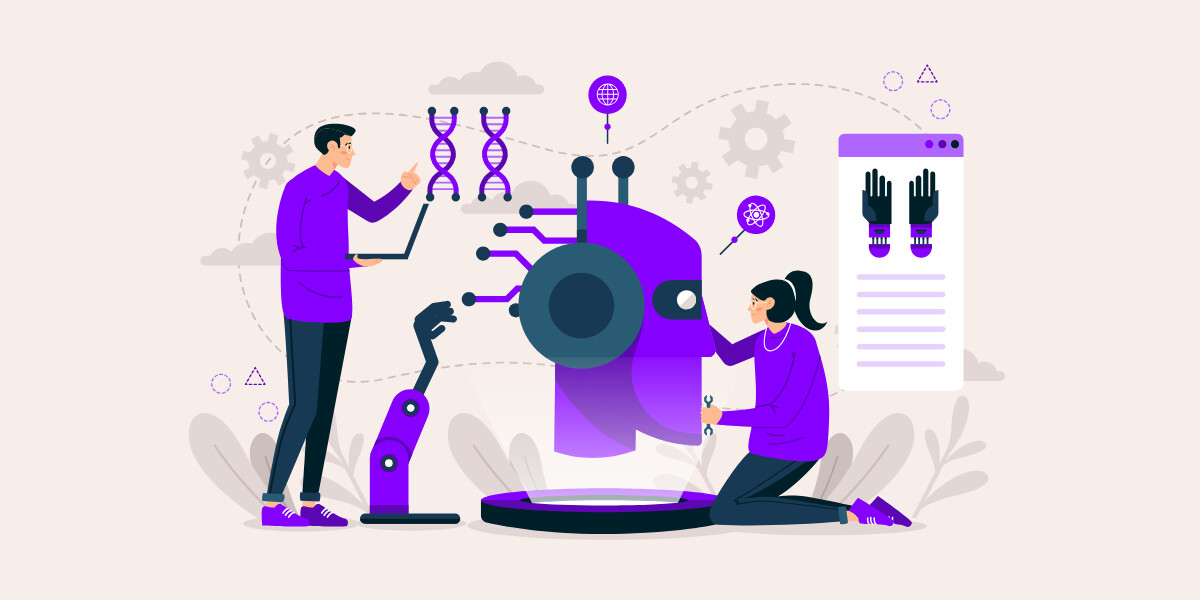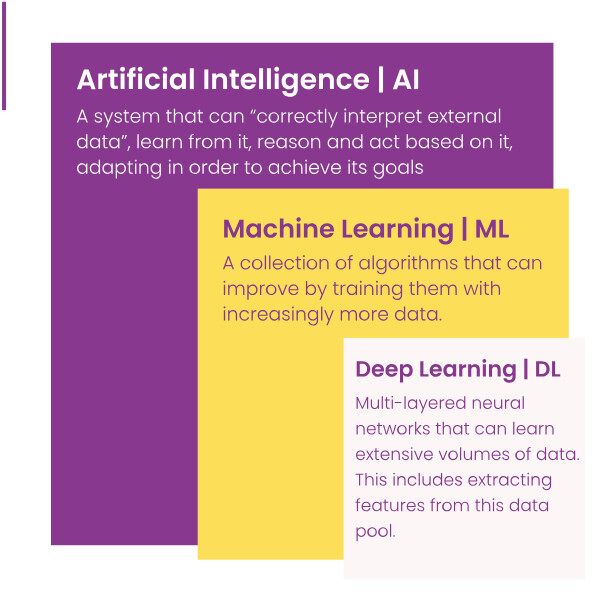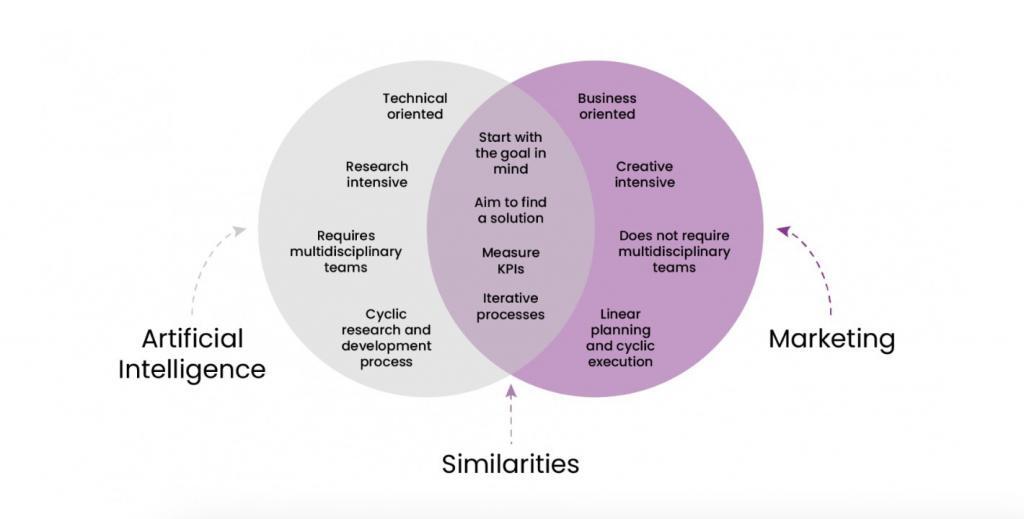
Embracing Artificial Intelligence In Marketing
Three of the biggest challenges marketers bump into include difficulty getting a holistic view of customers across all interactions, difficulties tracking marketing effectiveness, and struggles in personalizing the customer experience without violating privacy.
What if I told you all of these issues can be fixed through AI in marketing?
Years of technological advancements have made the role of the CMO more diverse, providing millions of extra data entries, traffic sources, channels, and increased customer demands.
But artificial intelligence has been around for decades already. As many as 61% of marketers consider artificial intelligence in marketing to be the most important part of their data strategy. You too are probably using it on a daily basis on Google, social media, and even email.
Combining our experience in marketing AI, we found something very interesting connecting the two. AI projects are very similar to the very marketing campaigns you’re used to creating. All this given a common business context and attempt at data unification and gaining insights in real-time.
Next is everything you need to know to implement artificial intelligence methods and tools into your day-to-day marketing activities. I’m also having a look at the core differences and similarities between artificial intelligence projects and marketing campaigns so you can understand where you can blend the two fields with no extra efforts.
But what is artificial intelligence?
Artificial intelligence (AI) refers to the use of data by machines, bots, and systems that have been trained to behave and simulate human thinking. Both data scientists and web users like you and I have contributed to training these virtual machines into behaving like humans and making similar decisions to us.
Artificial intelligence is an ever-growing field and it no longer refers to simply making machinery intelligent like researchers from the 1950s would aim to. In particular, machine learning and deep learning have been used in business to increase revenue and gain more control over the data a company owns.
Most instances of artificial intelligence in marketing today are based on machine learning from making customized product recommendations to helping you identify the most profitable promotion channels, predict your churn rate or customer lifetime value, and create better customer segments.
The process behind all these is simpler than it seems. You’ve got a large set of data that a specialized ML-based tool or model uses to learn patterns, similarities, and behaviors. The results will, in turn, help you make better predictions, estimates, and forecasts. With machine learning though, a human decision-maker has to intervene to see if a prediction is accurate and adjust the model for future processes.

On the other hand, deep learning works similarly to machine learning models but they use over a million data points and are able to determine if a prediction is correct. Since deep learning is a self-learning system, human intervention is no longer necessary so the results can be immediately used. Their complexity, computing power requirements, and high-cost are some of the reasons why they aren’t as widespread as machine learning models in today’s business and marketing processes.
So where do AI and marketing meet?
Artificial intelligence vs traditional software projects
AI projects, like traditional projects, start with a business problem. Commonly, this is a challenge that a company has been facing for a while and is not able to fix through other solutions. This issue can be anything, from wanting to improve data security to fixing IT bugs faster, creating better customer segments, tracking competitors’ moves in real-time, handling customer support requests promptly, sorting large amounts of data, and more.
With traditional software solutions, the approach is to perform requirement analysis, define the product specifications, and then develop the solution. With AI projects, the classic way of looking at specifications is entirely reversed. You’ve first got your data which you’re building up on to establish what the best solution would be. The method used in AI solutions is to start rapid experimentation after the requirement analysis instead of beginning the design and development process.
Another key difference is that AI projects are a bit more unpredictable. If in a regular project’s case you have a set task list and workflow that don’t often get modified, AI’s diverse and unexpected outcomes require more experimentation and freedom.
The Agile approach is the best option for AI projects as it allows you to work on both short-term and long-term goals and switch up your strategy after each delivery cycle. This being said, change management also holds higher importance with artificial intelligence projects as it attempts to support the organization for whatever change can occur.
At MorphL, we’ve seen that the AI product development lifecycle has to have three vital components:
- Ideation
- Research
- Engineering
For most of the AI solutions we’re developing, connecting these components is done through an Agile AI Product Development Lifecycle, a framework proposed by Adnan Boz in his AI Solution Product Management course (AISPM) at Stanford.
As you can see, this does NOT follow a linear product development lifecycle as shown below, beginning with data collection and proceeding with model training and engineering. Although we did apply this method a few times over the years, we noticed that it failed almost every time.
Instead, the AI solution development is a cyclic process where each iteration evolves into a solution. Starting with the Design Sprint we usually have a viable prototype within as fast as one week. Moving the Requirement and Data Analysis phase after the Design Sprint allows us to concentrate on a much narrower scope. In turn, this shortens the total time to five days.
Later we continue with the AI Solution Research and then Rapid Experimentation cycles to produce a working solution even before entering the Software Development Cycle. This cycle is specific to AI projects and lets you run a research initiative beyond project completion. At the final stage, we enter the Software Development Lifecycle where the engineering teams build the software solutions and improve these solutions.
One aspect I would like to emphasize is that AI projects fundamentally represent a search for an answer. During this search, we iterate over different aspects of the AI solution and seek to find the best answer to a given problem. From the higher tiers of the search, where research is focused on finding the right framework, to lower tiers where we search for some parameters of the ML algorithm, it is a continuous cycle process.
Just to put things into perspective, on average, an ML model at MorphL goes through over 25 iterations before it’s considered stable and moved from the proof-of-concept status to testing and production.
Finally, as the AI project becomes core to the company, it goes into business and operations. This is when you as a marketer will take over part of the responsibility. For years, AI has been shaping marketing to the extent that you probably can’t imagine doing marketing without it. It’s Google’s algorithm, Amazon’s product recommendation engine, custom ads segments, your own brand’s Messenger chatbot… No social media or top website we use is free of AI.
Running marketing campaigns
Marketing doesn’t work in a silo. While work starts in the team, it then involves the product, client support, sales, and operations teams as it grows and becomes core to the business. The reason why marketing remains vital to any business is its ability to increase sales, bring in new customers, generate leads, raise brand awareness, and improve overall customer satisfaction.
Marketing campaigns are used to promote products and services via different mediums by following certain themes and messages that help position a brand on the market, driving the top of the funnel and generating pipeline for the business.
Just like AI projects, marketing campaigns always start from a business goal, like wanting to raise the number of leads, increase brand awareness, have more downloads for an app, or just reach out to more people so you can boost your sales.
Most companies start from their annual goals and gradually build SMART goals for quarterly and monthly time frames. Having one or multiple targets can tell you what resources and approaches you’ll need, how you can quantify those goals, and what your budget could look like.
Each one of these goals is then taken through a brainstorming and ideation process in order to find the best strategies. Marketers look at their target audience, the assets they need, the implementation resources (channels, budget, tactics, messaging, etc.), so they can build the right marketing strategy.
After these tactics are executed, marketers need to have systems in place to measure all results, so they can integrate learnings into future campaigns. Thanks to the insights you’ve just benchmarked, your next marketing decisions will bring in better and more profitable results. This measurement step is often skipped but it holds a dominant role in dictating whether future campaigns will be successful or not, easing the decision-making process and preventing errors or income loss.
Marketing and AI

Similarities
“Best practices about building AI products say that it starts with the business problem you’re trying to solve. Then you analyze, collect and annotate the data you need to train your models. You then measure the output and tune your models, so they continue working in the real world. The way I think about marketing is similar: starting with the business goal, looking at assets (channels, budgets, spokespeople, ebooks etc), building the strategy and tactics, then measuring output and tuning during the campaign.”, Titus Capilnean, Director of Corporate Marketing at Appen
In many ways, running a marketing campaign and building an AI-based project have similar goals. From increasing ROI to providing in-depth insights into the way consumers think and make a buying decision or creating detailed customer profiles.
Both AI and marketing require KPIs for professionals to measure the final results and keep track of goals.
With marketing, KPIs are often clear to set. For instance, e-commerce marketers will set their key performance indicators based on the buyer’s journey stage (Awareness, Interest, Consideration, Purchase, Post-Purchase, Re-Purchase).
Take the Consideration stage as an example where most of the KPIs focus on user behavior. To name a few, the KPIs for this stage include bounce rate, time on site, number of site searches and/or sessions, returning users, pages viewed, etc.
Similarly, KPIs are just as important with AI projects, helping companies create better models, reduce costs, and even drive sales. These performance indicators are usually set during the proof of concept stage when the AI-based idea is tested so you can see if it’s a realistic and attainable opportunity.
As a KPI for artificial intelligence projects, technical performance, for instance, helps data engineers see if a model is accurate and scalable. Similarly, the data’s predictive value shows them if the data they have is enough and if its quality is enough to help them meet their goals.
Both fields also make use of similar data. They heavily rely on behavior stats, web analytics, customer insights, and the like to ensure that the results are accurate and can help you reach your business goals. While AI entirely depends on a set of data, marketing professionals can start running campaigns without having their own data to work with.
Yet, marketers will still have to turn to existing industry benchmarks to see what has worked for other companies before so they can tweak their strategies. In other words, AI projects and marketing campaigns will never be planned without some form of data to back them up.
Finally, you need to measure the results of both AI projects and marketing campaigns in order to move forward with your next projects. This is done to measure if the KPIs you’ve set were reached and change future project/campaign directions based on previous outcomes.
The measurement process aims to show data scientists and marketers why they couldn’t reach a KPI and what they should improve next. Safe to say that much of the day of both professionals is similar when it comes to measuring results.
Differences
We find that the differences between artificial intelligence and marketing more in each professional’s role. Marketers need more creativity to create their campaigns and, most often, don’t need technical skills to interpret the results of their strategies.
Data scientists and AI professionals use their coding and data mining skills on a day to day basis and rely heavily on technical expertise to get things done. Most of their goals are related to making the model work and ensuring technical scalability before getting to the general business goals.
AI vs Automation
We found that a leading issue in marketing is the confusion between AI and automation. The easiest way to distinguish the two is to think of two machines: one is simply doing what you instruct it based on a set of rules while the other is gradually learning to behave and think like a human being.
In other words, with marketing automation software like Marketo, Salesforce, or HubSpot, you’re making use of a static and predefined set of rules that help you take care of tasks without requiring human intervention. The tool has been programmed beforehand to respond in a specific way to the static rules and input you set.
However, this type of software doesn’t learn from the data you provide, it just renders it in a specific way so you can schedule your tweets at a specific time, set triggers for when an email sequence should be sent by the system, and so much more. You are the one doing the learning and editing the automation as you iterate on the campaign.
“Intelligent” machines and apps don’t just follow your orders. They use the data you provide to create their own predictions or recommendations and they learn from these in time. Compared to automated tools that simply collect data and rely on you and your team to make edits, AI tools can understand and react to context changes, with more advanced versions even making their own decisions independently.
For example, being able to predict the buying power of a customer. The Customer LTV model from MorphL empowers marketers to define intelligent automation workflows that are personalized for each customer, at scale.
Here’s how it works:
- User GA1234.56789 browses your e-commerce website, but doesn’t buy and leaves.
- The same user comes back a few days later. Since this is a returning user, MorphL identifies that the likelihood of GA1234.56789 to purchase a certain product is 55%. The question is: How can you increase the probability of that user to make a purchase, without leaving money on the table?
- MorphL can automatically trigger an action to display a discount code, with the right amount, for the right user GA1234.56789, at the right time, in, for example, your Shopify marketplace. This is based on the implicit intent of GA1234.56789 to buy that item as calculated by the machine learning algorithm.
As a marketer, you’re just defining the limits of the automation framework. What you offer, how big (or small) of a discount, on what page, at what time, and whom to target is up to the AI system.
How to get started with artificial intelligence in marketing
Applying artificial intelligence in marketing strategies is a relatively easy feat as you’re probably already using it to some extent.
Google’s search algorithm and all the recommendations you get are primarily based on machine learning and most big brands already have a chatbot that takes over the first interactions a customer has with a brand. Not to mention that tools like Grammarly have made use of natural language processing (NLP) to learn to speak and write as humans do (or even better).
All of these are just a couple of the infinite use cases of artificial intelligence in marketing. You can also apply AI to identify user search intent, create customized ads in a matter of seconds, analyze millions of data entries, and so many more situations.
Just like every step you’d take for a marketing campaign, start by identifying a core business goal you haven’t been able to solve so far. Chances are there’s already an easy-to-use AI-based solution available on the market whether you want to create better customer segments, send relevant emails at the right time, or acquire more leads.
As the best practices for every new technology are still under development, make sure you take into account the specifics of each tool you opt for. A cheap tool might not be able to provide all the results you want, plus it often means a low quality when it comes to usability and customer experience.
Most advanced solutions do require a data scientist for set up, maintenance, and even data interpretation so that will bring in solid and consistent results at the expense of your budget. You might also want to start experimenting with AI in marketing within the backend of things, testing it on data analytics first and then moving on to customer-facing chatbots.
